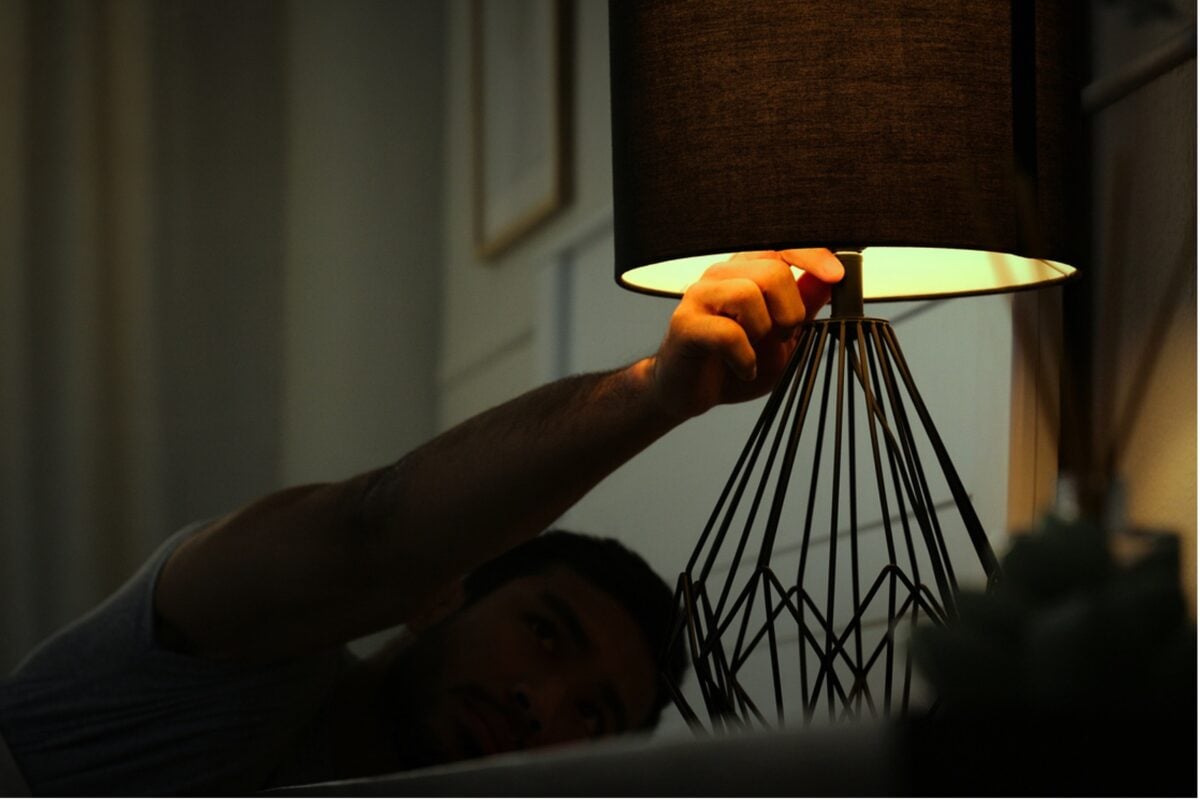Píldoras para dormir y auxiliares naturales para dormir
Qué hay que saber sobre los auxiliares para dormir recetados y de venta libre

Do you often lie awake for hours in bed wishing you could fall asleep faster? Experiment with these tips to calm your mind and put an end to tossing and turning at night.

It’s not unusual to experience the occasional restless night. Sometimes, you feel tired but find yourself tossing and turning when you get into bed. Other times, your thoughts keep fixating on stressful “what-if” situations, or you agonize over past events or perceived mistakes. Minutes turn into hours as you lie in bed and you’re no closer to sleep. It’s a frustrating experience that can leave you wondering, “Why can’t I shut off my brain and fall asleep?”
Lying awake, struggling to get to sleep at night can impact you the following day. It can feel like you’re drifting through life feeling groggy and unmotivated. In the workplace, you may struggle to focus on tasks. In social situations, you might feel short-tempered and unenthusiastic.
When falling asleep becomes a consistent problem, it can have more serious mental and physical health consequences. Regularly getting less than six hours of sleep a night can weaken your body’s immune system and increase your risk of cardiovascular disease. It can also increase your risk of mental health issues like depression and anxiety. Day-time fatigue after a sleep-deprived night can lead to more accidents, at home, work, and on the road, and generally make you more error-prone.
So, what exactly is stopping you from falling asleep?
Anxious or intrusive thoughts (often stemming from life’s many stressors) can often prevent you from falling asleep quickly. You might be unable to stop mentally replaying an argument you had with your partner earlier, for example, or from fixating on financial issues or problems at work. In these cases, distraction techniques and soothing relaxation practices can often provide speedy antidotes. It’s also crucial to treat any underlying condition—such as depression, insomnia, or chronic pain—that may be preventing you from falling asleep.
Whatever the reason you can’t fall asleep quickly at night, there are ways to reframe negative thoughts, calm your mind, and ease your restlessness so you can enjoy longer, more refreshing sleep.
Everyone is different, but most healthy adults should be able to fall asleep at night within 10 to 20 minutes. If it takes you longer than 30 minutes, it may be a sign that you have an underlying condition, such as insomnia.
However, it’s also possible to fall asleep too quickly. If you regularly fall asleep as soon as your head touches the pillow, it may be a sign that you’re suffering from sleep deprivation. In other words, you’re not getting enough quality sleep at night.
This could be due to a sleep disorder, such as sleep apnea, where your breathing is frequently interrupted while you sleep, disrupting your rest at night and leaving you feeling tired during the day. Sleep apnea is often accompanied by loud snoring, choking, or gasping while you sleep. It can cause serious health problems so it’s important to speak to your doctor right away.
If it’s taking you an age to finally drop off at night, by experimenting with the following tips, you can learn to ease any stress and anxiety, quieten your mind, and improve how well you sleep at night.
Sleep hygiene encompasses the basic steps to improving sleep quality. The following tips may not guarantee you fall asleep instantly every night, but they can reduce the hurdles that often stand between you and a restful night’s sleep.
Make your bedroom quiet and dark. Environmental factors like light and sound can interfere with your sleep quality. Use an eye mask and ear plugs light and noise.
Adjust the temperature to a cooler setting. The ideal sleep temperature is often somewhere from 60 to 68 degrees Fahrenheit, but this can vary widely from person to person. For example, one 2023 study found that older adults may sleep better when the temperature is between 68 and 77 degrees. Hotter temperatures generally lead to worse sleep quality.
Be consistent with your sleep schedule. Try to go to bed and get out of bed at the same time each day. This can improve sleep quality because it helps you establish a habit and get in sync with your internal clock.
Cut back on caffeine products like coffee, energy drinks, and chocolate. The stimulating effects of products like caffeine can take up to eight hours to wear off. Substances like nicotine and alcohol can also interfere with sleep quality.
Avoid big meals and drinking too much water before bed. If you eat too much, your sleep might be affected by indigestion. Similarly, drinking too much water or other fluids can lead to waking up in the the night to use the bathroom.
Avoid long late afternoon naps that may interfere with your sleep schedule. Naps might be handy in fighting off fatigue, but try to limit them to 15 to 20 minutes otherwise they can also leave you feeling groggy.
Lingering stress from the past or anxiety about the future can make it hard to wind down and fall asleep at night. Deep breathing exercises allow you to address the problem from a physiological approach. It’s possible to use your own breathing patterns to switch off your body’s sympathetic nervous system (also known as the fight-or-flight response) and activate the parasympathetic system (rest-and-digest). The key is to breathe slowly and deeply from your diaphragm.
If you find it difficult to remember 4-7-8, know that you can achieve a similar calming effect by simply keeping your inhales shorter than your exhales. For example, you might decide to inhale for four seconds and then exhale for six seconds. Whatever you decide on, keep count of the breaths you take, as this can serve as a mental distraction as well.
For a guided deep breathing exercise, listen to HelpGuide’s Deep Breathing Meditation.
Some research points to mindfulness meditation as a useful practice for lulling you to sleep quickly, even if you struggle with insomnia. Mindfulness is your ability to be present and nonjudgmental, so these practices require you to tune into what’s around you. Then, you continually gently bring your attention back to the present if your mind begins to wander.
The following exercise is called a body scan, and it draws your attention to your body itself. You mindfully focus on each part of the body, observing sensations but not attaching “good” or “bad” labels to them.
You can also try a variation of this exercise: progressive muscle relaxation meditation. Instead of simply noticing each body part, you tense and relax each one.
The more frequently you practice mindfulness meditation, the better. The effects add up over time, leading to increased focus, reduced stress, and improved sleep. Also know that mindfulness doesn’t need to be a long, complicated ritual. Try out mini-mindfulness practices daily, such as measuring your breath as you walk or paying attention to the taste of your food.
Research shows that imagery distraction techniques are another viable way to help you fall asleep faster. However, the well-known exercise of counting sheep may not be enough for many people, since it’s too mundane to keep your attention. The distraction needs to take up more cognitive space so your thoughts don’t wander. Try to engage your senses with the following practices:
Imagine yourself relaxing in a hammock on the beach. What does the breeze feel like? Can you hear the splashing of waves or the sound of friends nearby?
Or picture yourself lying on a blanket in a meadow. Fill in the imagery. What do the birds sound like? Is your face in the shade while your feet are being warmed by the sun? What does the blanket feel like under you? Get creative as you craft the scene.
[Listen to helpGuide’s Sleep Meditation Using Guided Imagery]
Some people find it helpful to use sensory aids when imagining a calming scene. Maybe you listen to audio of waves lapping the shore or crickets chirping in a field. Of course, these types of sounds could also make it harder for some people to sleep, so experiment to determine what works best for you.
You can also incorporate elements of aromatherapy. For example, the smell of lavender oil could help crystalize your vision of a peaceful meadow. As a bonus, the scent of lavender oil may also help to improve your sleep quality.
Cognitive refocusing is a technique that involves focusing on a mental task that completely holds your attention but doesn’t stir you up emotionally. The type of mental task will vary from person to person, but it should be engaging enough to distract you from the stressful thoughts and ruminations that keep you up at night.
Some examples:
Again, the key here is to find a cognitive task that isn’t emotionally arousing. So, if the thought of running football plays really excites you or the thought of redecorating is stressful, those might not be helpful. Spend a little time thinking about what works for you and have the task in mind before you get into bed at night.
The military sleep method has been popularized on social media in recent years, with many people claiming it can help you fall asleep within two minutes. First appearing in Bud Winter’s 1981 book Relax and Win: Championship Performance, the military method combines several proven relaxation techniques, like the deep breathing and body scan exercises.
One study suggests that writing a to-do list before bed may help you fall asleep faster. There is a catch though. The more specific the details of the to-do list, the faster you’re more likely to fall asleep.
Keep a notebook next to your bed and complete this five-minute journaling exercise each night:
The idea behind this exercise is that, by writing things down, you “offload” your anxieties about completing them or remembering to complete them. This might be especially useful if you have difficulty sleeping because you often worry about all the things you need to get done.
Another version of this exercise is to journal about the things that you’re worried about, not just the things you hope to accomplish. Write your worries on a piece of paper, and then tell yourself that you will work to resolve them tomorrow when you’re more alert and creative.
If more than 20 minutes pass and you still find yourself wide awake, it might be time to take a different approach. Relocate to a dimly lit space and engage in a calming activity. Exercise or watching TV might seem like good ways to tire yourself out, but physical activity and screens will actually have the opposite effect. Instead, try some of the above-mentioned relaxation exercises. Or try another comforting activity, such as reading a book by a soft light or listening to soothing music.
If you start to feel increasingly discouraged about how long it’s taking you to fall asleep at night, consider adjusting your goal. When you make sleep your goal, you may begin to fret about it more, which can be counterproductive and keep you awake at night. Instead, try to focus on relaxing. By making relaxation your objective, you may be able to ease the pressure off yourself and quieten your mind so that sleep comes easier.
Última actualización o revisión el julio 19, 2024Millones de lectores confían en HelpGuide.org para obtener recursos gratuitos basados en evidencia para comprender y afrontar los desafíos de la salud mental. Haga su donación hoy para ayudarnos a salvar, apoyar y cambiar vidas.
Done hoy a HelpGuide.org